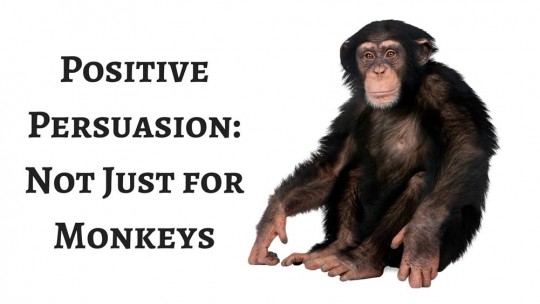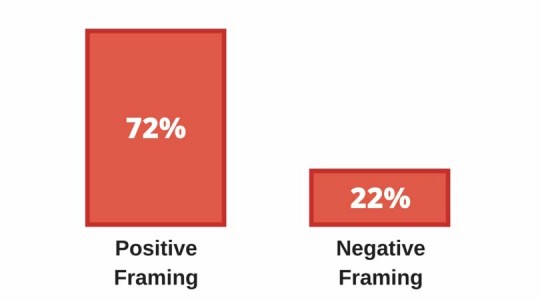How To Use Positive Framing to Persuade and Sell

You may not sell to chimps and bonobos, but a fascinating new experiment shows that our human preference for the positive is an evolved trait and deeply rooted in our psyche.
Scientists at Yale and Duke set out to find if “positive framing” affected primates other than humans. Scientific American described the experiment:
Even chimps prefer positive framing. Use it in #copywriting. pic.twitter.com/4TiWyZMA2V Share on X[The researchers} gathered 40 of our closest living relatives—23 chimpanzees and 17 bonobos—and offered them options for choosing food: either one or two fruits versus a constant number of peanuts. Sometimes the apes were shown one piece of fruit each time they made the selection, but half the time they were given two: positive framing.
In other trials, the apes were initially presented two pieces of fruit, but half the time they got only one: negative framing. Regardless of the framing, the apes ended up with an identical quantity of fruit. Yet they were more likely to choose fruit when they were offered the single fruit with its frequent “bonus” than the double fruit with its frequent “loss.”
What is Positive Framing?
Humans have dozens of cognitive biases. (Check out Jeremy Smith‘s massive post, 67 Ways to Increase Conversion with Cognitive Biases, to see just how many.) In each of these bias scenarios, our behavior may be affected by “irrational” factors, such as the way information is presented to us.
A classic Kahneman and Tversky experiment illustrates the positive framing bias. The scientists presented treatment options for a hypothetical disease in two ways, one emphasizing the positive outcomes and one the negative.
Wikipedia summarizes the options in simple terms:
| Framing | Treatment A | Treatment B |
|---|---|---|
| Positive | “Saves 200 lives” | “A 33% chance of saving all 600 people, 66% possibility of saving no one.” |
| Negative | “400 people will die” | “A 33% chance that no people will die, 66% probability that all 600 will die.” |
Even though the actual outcomes were identical, the difference in preference was startling. Under the positive framing condition, 72% of the subjects chose Treatment A. But, when the framing was negative (400 will die), just 22% chose Treatment A.

Study: Positive framing was 3 times more persuasive than negative. pic.twitter.com/No4SKrDu1i Share on X
This obviously has real world implications. A doctor could tell a patient suffering from a potentially fatal disease that surgery has a 90% chance of leading to a full recovery. Or, she could tell the patient one out of ten patients will die from the surgery. The probabilities are the same, but it’s likely that more patients hearing the second description would forego the surgery.
Fear of Loss vs. Positive Framing
At first glance, these positive framing experments seem to conflict with another powerful cognitive bias, fear of loss. (See, for example, How “Loss” Can Be a Winning Strategy and Blog Headline Writing Lessons from Mega-traffic Sites.)
So should marketers emphasize the positive or negative?
The way to maximize the impact of your marketing message is simple. Express the risk in negative terms, but present your solution using positive framing.
More simply, you should lead with the scary possibility of loss, but be sure to offer the solution using positive language.
For example, imagine you are offering a shockproof case for smartphones. It would be fine to lead with a “fear of loss” headline like, “The Average Cost to Replace a Broken Smartphone is $322.76” or “Can You Afford $322.76 to Replace Your Broken Smartphone?”
Those scary headlines will invoke fear of loss.
But, your solution should be expressed in positive terms, like “95% of smartphones with our case survived this drop…” I’d use that language rather than the equivalent negative framing, “Only 5% of smartphones with our case broke when dropped…”
Sometimes, a negative statistic may seem more impressive. Or it may seem to flow better. For example, if you lead with, “2 out of 3 smartphones break when dropped like this…” it might seem tempting to follow up with, “Just 1 in 20 breaks when protected by our case.” That would be a mistake.
Don’t monkey around. If you are presenting a solution to your customer’s problem, present it in the most positive way you can.
How You Can Use Positive Framing to Persuade and Sell pic.twitter.com/4TiWyZMA2V Share on X
